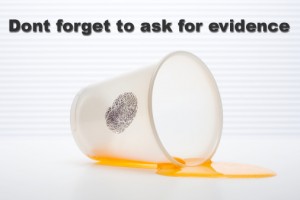Identifying risks and evaluating risk mitigation techniques requires auditors to gather evidence to support conclusions. This evidence must be sufficient, relevant and reliable. Classic textbooks on auditing divide evidence into several categories, however, I like to take a more practical/simplistic approach and categorize evidence as either testimonial or documentary.
Testimonial Evidence
In non legal terms, testimonial evidence is an oral or written assertion or description. Auditors obtain this evidence during inquiry and observation interviews with clients.
Documentary Evidence
Documentary evidence includes original records such as journal entries, checks, receipts, etc. It also includes any media by which information can be preserved including pictures, audio recordings, screen prints, and copies.
Auditors obtain a wealth of testimonial evidence via interviews and directly observing processes. The difficulties often arise when there is a need to collect documentary evidence. There are a few things to remember about evidence:
- Audit evidence is more reliable when it exists in documentary form
- Original documents are more reliable than photocopies
- Evidence obtained from knowledgeable/competent independent sources is more reliable
- Internally generated documents are more reliable when the underlying process controls are effective
- Evidence obtained directly (i.e. observation) is more reliable than that obtained indirectly (i.e. hearsay)
So what does this mean for auditors?
When conducting interviews, pay close attention to what your clients are communicating. Be sure to look for opportunities when you need to move from testimonial evidence to requesting documentation. Do not be afraid to ask for documentation. For example, you can use the power of paraphrasing to ask supporting documentation. When a client has explained a process to you try saying something like, “If I understand you correctly, you are saying that the process functions as follows” and then describe what has been communicated to you in your own words. If your understanding is correct, ask the client for additional documentation so that you can better document your understanding the process.
Summary
- Observation and inquiry is a great way to understand a clients operation
- Observation and inquiry provides testimonial evidence
- Documentary evidence is more reliable than testimonial evidence
- Obtain documentary evidence by simply asking clients
- It’s okay to ask after the interview if you forget during the interview process.
[fusion_builder_container hundred_percent=”yes” overflow=”visible”][fusion_builder_row][fusion_builder_column type=”1_1″ background_position=”left top” background_color=”” border_size=”” border_color=”” border_style=”solid” spacing=”yes” background_image=”” background_repeat=”no-repeat” padding=”” margin_top=”0px” margin_bottom=”0px” class=”” id=”” animation_type=”” animation_speed=”0.3″ animation_direction=”left” hide_on_mobile=”no” center_content=”no” min_height=”none”][divider]
[divider]
[/fusion_builder_column][/fusion_builder_row][/fusion_builder_container]

